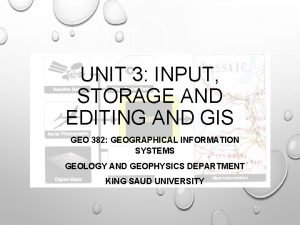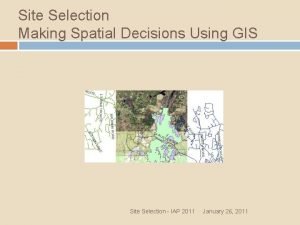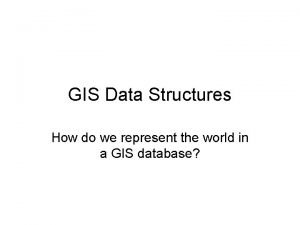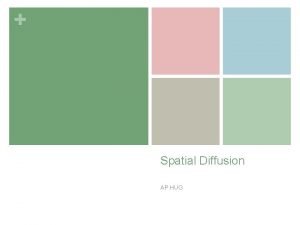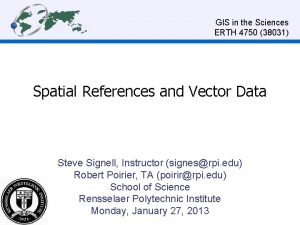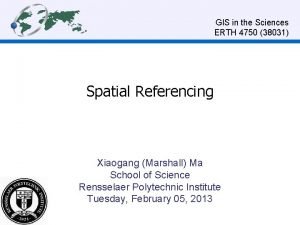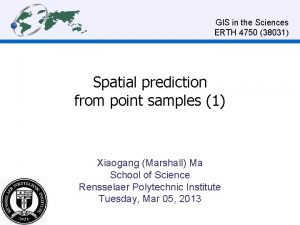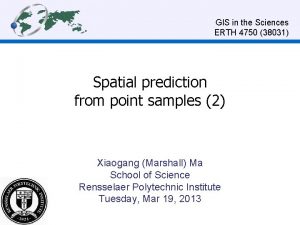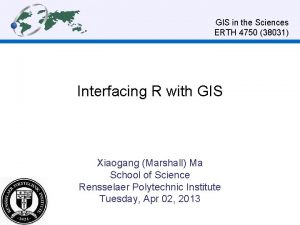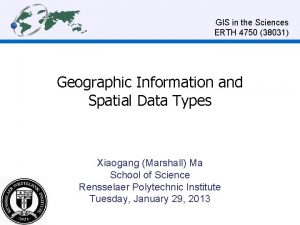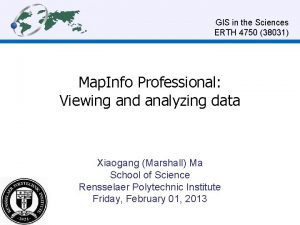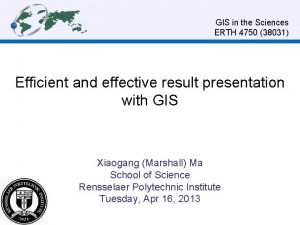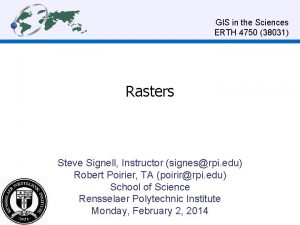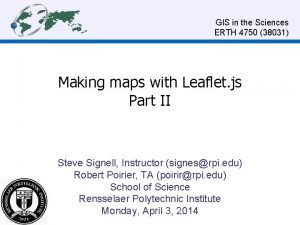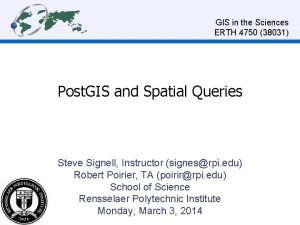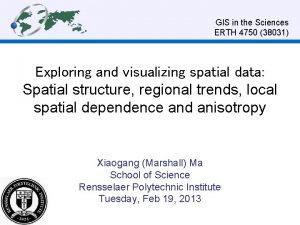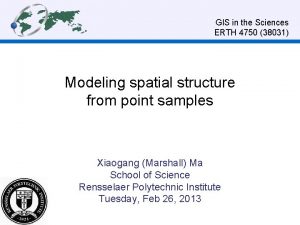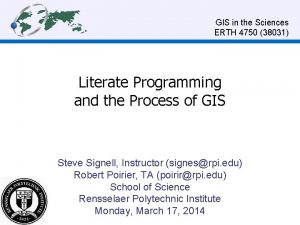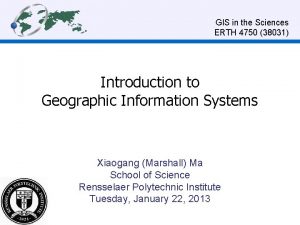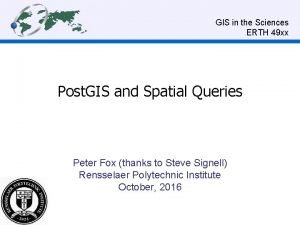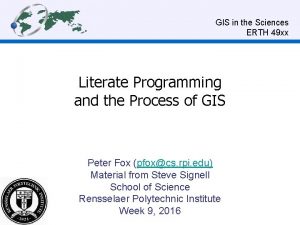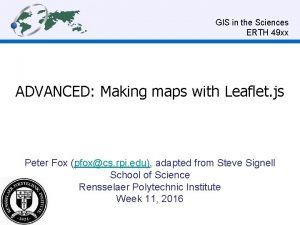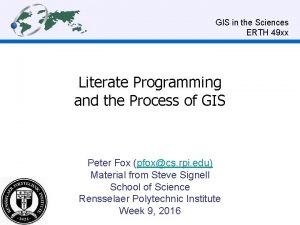GIS in the Sciences ERTH 4750 38031 Spatial






















































- Slides: 54

GIS in the Sciences ERTH 4750 (38031) Spatial Referencing Xiaogang (Marshall) Ma School of Science Rensselaer Polytechnic Institute Tuesday, February 05, 2013

Review of last week’s work • In the lecture – Geographic phenomena: fields and objects – Computer representations: raster and vector – Autocorrelation and topology • In the lab: Map. Infro Professional – Map objects: text, points, lines and polygons – Objects layers, tables maps – Analyzing data: queries & thematic Maps • Questions?

Acknowledgements • This lecture is partly based on: – Huisman, O. , de By, R. A. (eds. ), 2009. Principles of Geographic Information Systems. ITC Press, Enschede, The Netherlands

Outline 1. Spatial referencing basics 2. Map projections

1 Introduction • Spatial referencing encompasses the definitions, the physical/geometric constructs and the tools required to describe the geometry and motion of objects near and on the Earth’s surface – Some of these constructs and tools are usually itemized in the legend of a published map

1 Introduction Legend of a German topographic map

2 Spatial referencing basics (a) International Terrestrial Reference System – the origin is in the center of the mass of the Earth. This system rotates together with the Earth. Used in extra-terrestrial positioning systems, like GPS (b) International Terrestrial Reference Frame – a set of points with high precision location and speed definition (a triangle-based network). The speed expresses the change of location in time due to geophysical (e. g. tectonic) phenomena

2. 1 Basic coordinate systems Geographic coordinates – Twodimensional coordinate system, referring to locations on (or close to) the surface of the Earth, using angles for defining locations Cartesian coordinates – Rectangular coordinate system, using linear distance for defining locations on a plane

2. 2 Shape of the Earth • Development of the ideas about the shape of the Earth: – An oyster (The Babylonians before 3000 BC) – A circular disk (early antiquity; approximately 5 -300 B. C. , but this concept survived till the 19 thcentury) – A very round pear (Christopher Columbus in the last years of his life) – A perfect ball a sphere(Pythagoras in 6 thcentury BC) – An ellipsoid, flattened at the poles (Newton around the turn of the 17 th and 18 th centuries) – …but what is it exactly? Modeling the shape of the Earth is needed for spatial referencing. In this sense, topographic differences (e. g. , mountains and lowlands) are not taken into account.

2. 2 Shape of the Earth • The geoid – The surface of the Earth is irregular and continuously changing in shape due to irregularities in mass distribution inside the earth. – Geoid: An equipotential surface in the gravity field of our planet; a ‘potato’ like shape, which is ever changing, although relatively slowly. – Every point on the geoid has the same zero height all over the world.

2. 3 Datums • For spatial referencing we need a datum: a surface that represents the shape of the earth. • Due to practical reasons, two types of spatial positioning are considered: – Computing elevations (related to a vertical datum), – Computing horizontal positions (related to a horizontal datum). Source of clip art: http: //www. school-clip-art. com

2. 3. 1 Vertical datum • A reference surface for heights (vertical datum) must be: – a surface of zero height, – measurable (to be sensed with instruments), – level (i. e. horizontal). • The geoid is practically the most obvious choice: – the geoid is approximately expressed by the surface of all the oceans of the Earth (mean sea level), – every point on the geoid has the same zero height all over the world.

Mean sea level = geoid? • Mean Sea Level (MSL) is used as zero altitude – the ocean’s water level is registered at coastal locations over several years • Sea level at the measurement location is affected by tidal differences, ocean currents, winds, water temperature and salinity • Many of these local vertical datums Tide table of Isle aux Morts exist (Canada). Sea surface changes predictably but irregularly. Source: http: //www. lau. chs-shc. dfompo. gc. ca/cgi-bin/tide-shc. cgi – Different countries, different vertical datums. – E. g. : MSLBelgium-2. 34 m = MSLNetherlands

Vertical datum in the United States • The North American Its inscription reads "State of Colorado Vertical Datum of 1988 / 2003 Mile High Marker / 5280 Feet (NAVD 88) Above Sea Level / NAVD 88". Elevation marker at The Colorado State Capitol Source: http: //www. mesalek. com/colo/trivia/elev. html

Highest and lowest points in the US • Lowest point: Death Valley, Inyo County, California − 282 ft (− 86 m) below sea level • Highest point: Mount Mc. Kinley, Denali Borough, Alaska +20, 320 ft (6, 194 m) above sea level Source: http: //en. wikipedia. org/wiki/Geography_of_the_United_States

Elevation measurement from the vertical datum • Starting from MSL points, the heights of points on the Earth can be measured using geodetic leveling techniques

Geoid versus ellipsoid Rotation of this ellipse around the minor axis gives the ellipsoid • The geoid surface continuously changes in shape due to changes in mass density inside the earth (i. e. it is a dynamic surface). • Due to its dynamics and irregularities, geoid is NOT SUITABLE for defining timeindifferent elevations (as well as it is not a suitable reference surface for the determination of locations, see later). • A (regular) mathematical vertical datum is needed. • The best approximation of the geoid is an ellipsoid. Note that if a=b then it is a sphere.

Comparison of vertical datums • Elevations measured from different datums are different, thus, the datum has to be known for proper georeferencing.

2. 3. 2 Horizontal datum • For local measurements, where the size of the area of interest does not exceed 10 km, a plain is a proper horizontal datum for most of the applications. Note that the ellipsoid is not a plain. A • For applications related to map projection has to be applied (see larger areas the curvature later in this lesson) to represent the of the Earth has to be points on the ellipsoid in the plain of considered. the map. ppt • Mathematically describable surface: ellipsoid (sphere).

Local horizontal datums • Countries establish a horizontal datum – an ellipsoid with a fixed position, so that the ellipsoid best fits the surface of the area of interest (the country) – topographic maps are produced relative to this horizontal (geodetic) datum • Horizontal datum is defined by the size, shape and position of the selected ellipsoid: – dimensions (a, b) of the ellipsoid – the reference coordinates (φ, λ and h) of the fundamental point – angle from this to fundamental point to another point

• Hundreds of local horizontal datums do exist Most widely used datum-ellipsoid pairs Courtesy: https: //www. navigator. navy. mil

Local and global datums Local and global ellipsoids related to the geoid. The shapes are exaggerated for visual clarity.

Local and global datums • Attempts to come to one single global horizontal AND vertical datum: – Geodetic Reference System 1980 ellipsoid (GRS 80) – accurate global geoid in near future? • Among difficulties: – accurate determination of one ‘global’height – from hundreds of local datums to one global datum • If successful: – GIS users don’t have to bother about spatial referencing and datum transformation any more

Commonly used ellipsoids These selected ellipsoids are listed here as an example. There is no contradiction between this list and the figure in slide 18, since in all the regions several ellipsoids are used.

Horizontal datums - example Datum: ellipsoid with its location. Note that the above ellipsoids are the same, but their positions are different.

2. 3. 3 Datum transformations • Why ? – For the transformation of map coordinates from one map datum to another • What ? – Transformation between two Cartesian spatial reference frames • How ? – Transformation parameters (shift and modify ellipsoid) • Rotation angles (α, β, γ) • Translation (origin shift) factors (X 0, Y 0, Z 0) • Scaling factor (s)

3 Map projections • The curved surface of the Earth (as modeled by an ellipsoid) is mapped on to a flat plane using a map projection. • Two reference surfaces are applied: – Ellipsoid for large-scale mapping (e. g. 1: 50, 000) – Spherefor small-scale mapping (e. g. 1: 5, 000) See also: http: //www. bbc. co. uk/history/british/empire_seapower/launch_ani_mapmaking. shtml

3. 1 Classes of map projections • Surfaces used for projecting the points from the horizontal reference surface (datum) onto are: – plane or – a surface that can be deduced to a plane: • cone • cylinder • Any other (closed) body that consists of planes can be also used (e. g. a cube), but those are mostly of limited practical value.

Secant projections • In tangent projections the projection surfaces touch the reference surface in one point or along a closed line. • In secant projections the projection surface intersect the reference surface in one or two closed lines.

A transverse and an oblique projection • Normal projection: α=0º • Transverse projection: α=90º • Oblique projection: 0º<α<90º – Where α is the angle between the symmetry axis of the projection surface and the rotation axis of the Earth

Azimuthal projection example • Stereographic projection is used frequently for mapping regions with a diameter of a few hundred km. • Distortions strongly increase towards the edges at larger areas. Source: http: //www. colorado. edu/geography/gcraft/notes/mapproj_f. html

Cylindrical projection example • In this projection, Y coordinates are defined mathematically • Conformal projection • Mercator projection was used for navigation Source: http: //www. colorado. edu/geography/gcraft/notes/mapproj_f. html

Conic projection example • Parallels are conentric unequally spaced circles • Conformal projection • Used for areas alongated in W-E direction Source: http: //www. colorado. edu/geography/gcraft/notes/mapproj_f. html

3. 2 Properties of projections • The following major aspects are used for grouping the projections: – Conformality • Shapes/angles are correctly represented (locally) – Equivalence ( or equal-area ) • Areas are correctly represented – Equidistance • Distances from 1 or 2 points or along certain lines are correctly represented • The compromise projections do not have the above properties, but the distortions are optimized.

Conformal projection Shapes and angles are correctly presented (locally). This example is a cylindrical projection. Source: http: //www. colorado. edu/geography/gcraft/notes/mapproj_f. html

Equivalent map projection Areas are correctly represented. This example is a cylindrical projection. Source: http: //www. colorado. edu/geography/gcraft/notes/mapproj_f. html

Equidistant map projection Distances starting one or two points, or along selected lines are correctly represented. This example is a cylindrical projection. Source: http: //www. colorado. edu/geography/gcraft/notes/mapproj_f. html

Compromise projection (Robinson) Distortions are optimized. This example is a pseudocylindrical projection. Source: http: //www. colorado. edu/geography/gcraft/notes/mapproj_f. html

Projection systems used for topographic mapping in the World UTM: Universal Transverse Mercator TM: Transverse Mercator

3. 3 Principle of changing from one projection into another • Transformation from one Cartesian coordinate system (with a known Projection A) to another is done by: – 1. calculating the geographic coordinates for each point (inverse mapping equation) and then – 2. calculating the Cartesian coordinates using the forward mapping equation of the target Projection B.

Changing from one projection into another

Comparison of projections (an example) Here, two maps of Northern and Central America are overlaid with a practical match of the borders of the USA. The differences between the two geometries are increasing with an increasing distance from the matching central part.

3. 4 Classification of map projections Ø Class • Azimuthal • Cylindrical • Conical Ø Aspect • Normal • Oblique • Transverse Ø Property • Equivalent (or equal-area) • Equidistant • Conformal • Compromise Ø Secant or Tangent projection plane Ø ( Inventor ) There are several ways to classify map projections. Here, you find a set of criteria for classifications, which were discussed before. Note that the last criterium (Inventor) refers to map geometry which are not really geometric projections, but sets of mathematical/logical rules for converting φ and λ into x and y coordinates.

3. 5 Example of geometric information on a map Source: Mapa topografico nacional de Espana; IGN; Sheet 1046 -III On a map, the geometric information is presented in the colophon. This example is taken from a Spanish map.

3. 6 A frequently used mapping system: Universal Transverse Mercator (UTM) Transverse secant cylinder (6 o zones)

A UTM zone • Transverse cylindrical projection: the cylinder is tangent along meridians • 60 zones of 6 degrees • Zone 1 starts at longitude 180°(in the Pacific Ocean) • Polar zones are separately mapped • X coordinates – six digits (usually) • Y coordinates – seven digits (usually) Source http: //www. maptools. com/Using. UTM/UTMdetails. html

UTM zones 0 o 6 o

UTM zone coordinates • The origin of the Cartezian coordinate system is translated outside of the zone to ensure positive coordinate values: – Eastings are measured from the central meridian • with a 500, 000 m False Easting to ensure positive coordinates – Northings are measured from the equator • with a 10, 000 m False Northing for positions South of the equator

Two adjacent UTM zones A overlap between the zones facilitates continuous mapping

Some stories of normal Mercator projection Greenland (blue) on Africa (red) based on the standard Mercator projection map compared to the actual geographical size Image source: http: //www. pratham. name/mercator-projection-africa-vs-greenland. html

The true size of Africa Source: http: //flowingdata. com/2010/10/18/true-size-of-africa/

4 Summary • Spatial referencing basics – Basic coordinate systems – Shape of the Earth: the geoid – Datums: vertical datum, horizontal datum • Map projections – Classes of projections – Properties of projections – Projection transformations

Reading for this week • • Map Projection Overview Mercator projection Transverse Mercator projection Universal Transverse Mercator coordinate system 53

Next classes • Friday class: – Map. Info Professional: Buffering, projection and printing • In preparation: – Next Tuesday: Geo-statistical Computing and R 54
 Erth 616
Erth 616 4750 n sheridan
4750 n sheridan Spatial data vs non spatial data
Spatial data vs non spatial data Natural science tok
Natural science tok Gis data input
Gis data input Making spatial decisions using gis
Making spatial decisions using gis Gis data structure
Gis data structure độ dài liên kết
độ dài liên kết Thiếu nhi thế giới liên hoan
Thiếu nhi thế giới liên hoan Khi nào hổ mẹ dạy hổ con săn mồi
Khi nào hổ mẹ dạy hổ con săn mồi Bài hát chúa yêu trần thế alleluia
Bài hát chúa yêu trần thế alleluia điện thế nghỉ
điện thế nghỉ Một số thể thơ truyền thống
Một số thể thơ truyền thống Trời xanh đây là của chúng ta thể thơ
Trời xanh đây là của chúng ta thể thơ Số nguyên tố là
Số nguyên tố là đặc điểm cơ thể của người tối cổ
đặc điểm cơ thể của người tối cổ Tỉ lệ cơ thể trẻ em
Tỉ lệ cơ thể trẻ em Tia chieu sa te
Tia chieu sa te Các châu lục và đại dương trên thế giới
Các châu lục và đại dương trên thế giới Thế nào là hệ số cao nhất
Thế nào là hệ số cao nhất ưu thế lai là gì
ưu thế lai là gì Hệ hô hấp
Hệ hô hấp Các môn thể thao bắt đầu bằng tiếng nhảy
Các môn thể thao bắt đầu bằng tiếng nhảy Tư thế ngồi viết
Tư thế ngồi viết Bàn tay mà dây bẩn
Bàn tay mà dây bẩn Hát kết hợp bộ gõ cơ thể
Hát kết hợp bộ gõ cơ thể Cách giải mật thư tọa độ
Cách giải mật thư tọa độ Tư thế ngồi viết
Tư thế ngồi viết Thẻ vin
Thẻ vin Voi kéo gỗ như thế nào
Voi kéo gỗ như thế nào Thể thơ truyền thống
Thể thơ truyền thống Các châu lục và đại dương trên thế giới
Các châu lục và đại dương trên thế giới Sự nuôi và dạy con của hổ
Sự nuôi và dạy con của hổ Từ ngữ thể hiện lòng nhân hậu
Từ ngữ thể hiện lòng nhân hậu Diễn thế sinh thái là
Diễn thế sinh thái là Vẽ hình chiếu vuông góc của vật thể sau
Vẽ hình chiếu vuông góc của vật thể sau Slidetodoc
Slidetodoc Thứ tự các dấu thăng giáng ở hóa biểu
Thứ tự các dấu thăng giáng ở hóa biểu Làm thế nào để 102-1=99
Làm thế nào để 102-1=99 Lời thề hippocrates
Lời thề hippocrates Tư thế worm breton là gì
Tư thế worm breton là gì đại từ thay thế
đại từ thay thế Quá trình desamine hóa có thể tạo ra
Quá trình desamine hóa có thể tạo ra Cong thức tính động năng
Cong thức tính động năng Thế nào là mạng điện lắp đặt kiểu nổi
Thế nào là mạng điện lắp đặt kiểu nổi Dạng đột biến một nhiễm là
Dạng đột biến một nhiễm là Biện pháp chống mỏi cơ
Biện pháp chống mỏi cơ Bổ thể
Bổ thể Vẽ hình chiếu đứng bằng cạnh của vật thể
Vẽ hình chiếu đứng bằng cạnh của vật thể Stimulus diffusion definition
Stimulus diffusion definition Spatial database meaning
Spatial database meaning Cs bte
Cs bte Spatial locality
Spatial locality Spatial time
Spatial time Spatial outline
Spatial outline




